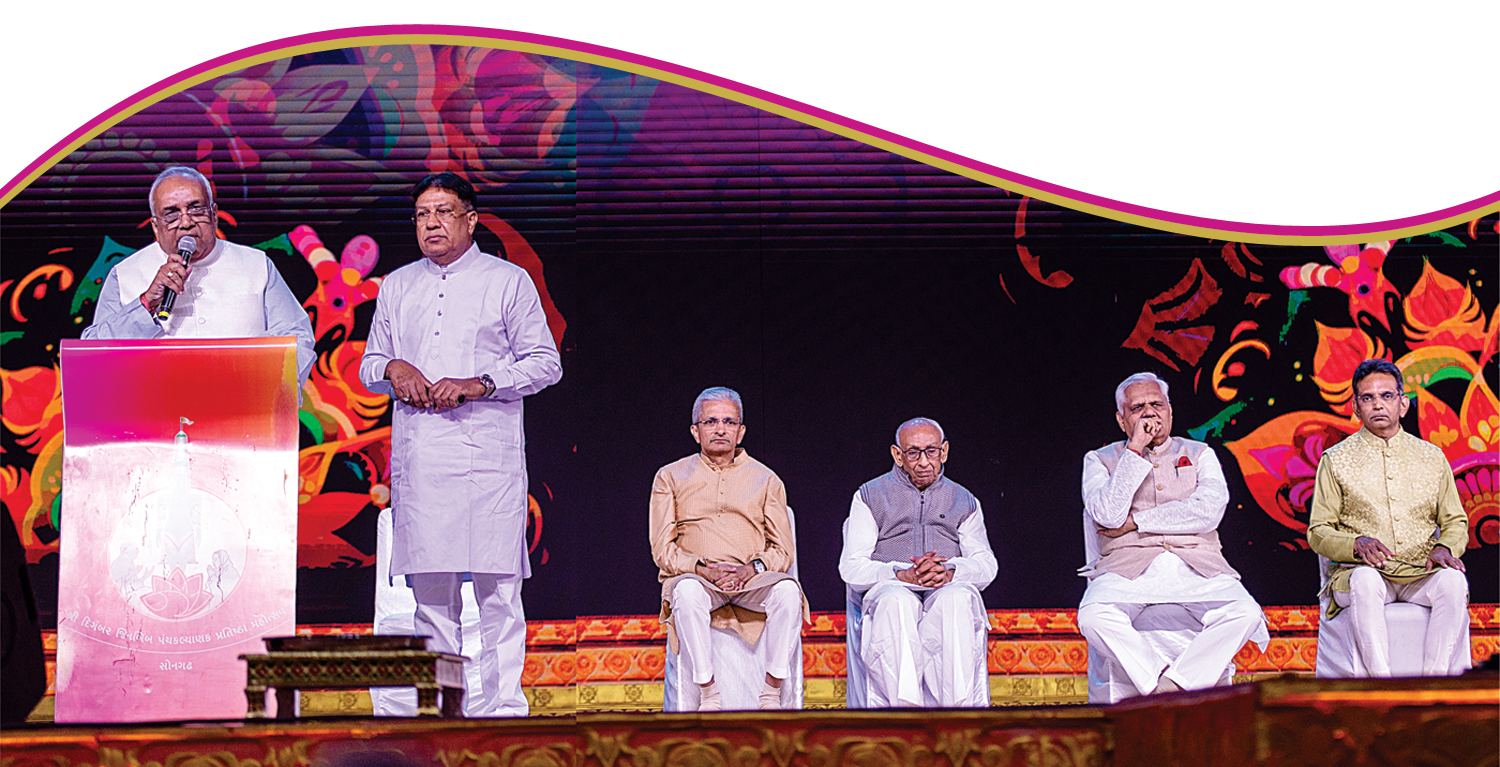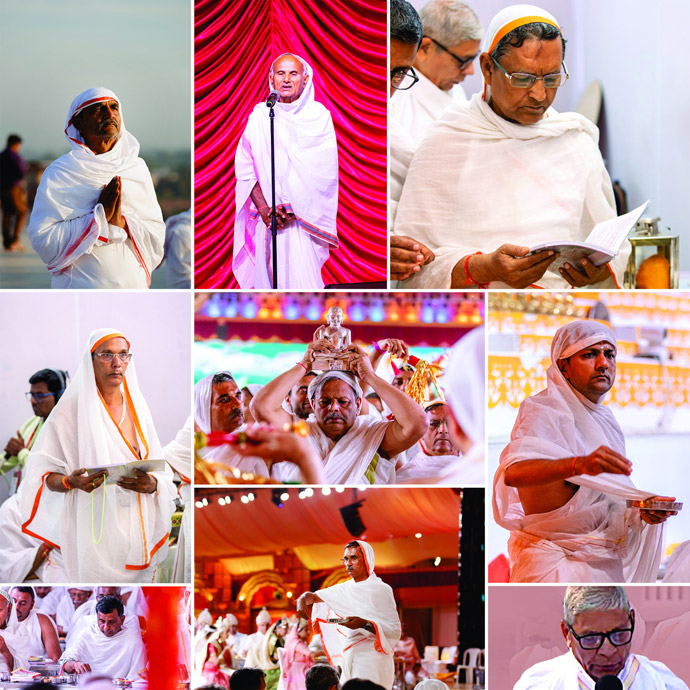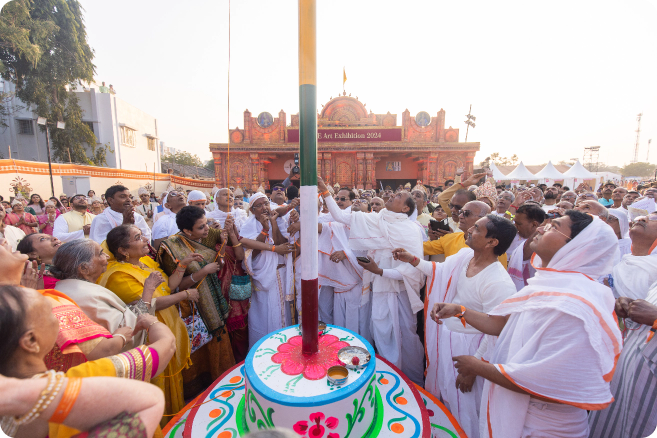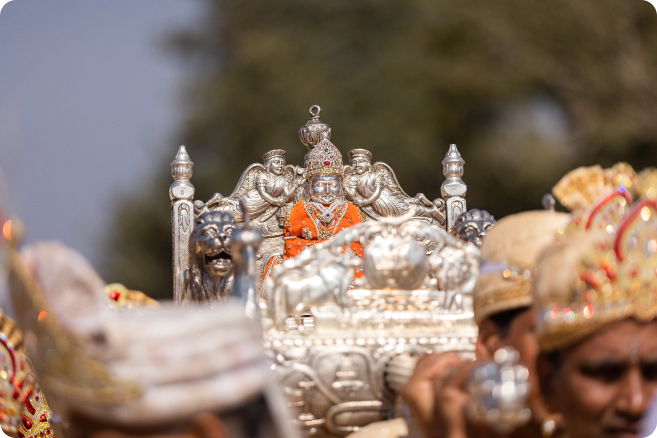Veer Samvat 2550, Paush Sud 9 to Paush Vad 1, Friday, 19th January to Friday, 26th January, 2024
अध्यात्मतीर्थ है सुवर्णपुरी, जहां बरसे ज्ञान धनेरा...
Veer Samvat 2550, Paush Sud 9 to Paush Vad 1, Friday, 19th January to Friday, 26th January, 2024
अध्यात्मतीर्थ है सुवर्णपुरी, जहां बरसे ज्ञान धनेरा...
Shri Aadinath Digambar Jain Panchakalyanak Pratishtha Mahotsav is a unique, unparalleled, and grand festival for the well-being of all souls. This festival is a celebration of rituals showcasing knowledge and detachment – essential for attaining liberation (moksha), and also an event that brings glory to the Jain religion.
Establishing unity with one’s eternal pure Soul and recognizing it as the ‘Self,’ meaning – believing “I am like Jinendra Bhagwan,” is known as Real Pratishtha or Nischay Pratishtha. On the other hand, instilling the supreme qualities of Lord Jina in an idol made of stone or metal is known as Conventional or Vyavahar Pratishtha.
Just as nutritious food is essential in keeping the body healthy, and thoughts of supreme truth are essential in keeping the soul healthy, similarly, the Panchakalyanak Pratishtha Mahotsav is essential to connect household life with the path to liberation (moksha). In this present difficult era, apart from the passionless deities, scriptures, and detached gurus, there is no other refuge. Even for devoted practitioners trying to remain steadfast on the path of detachment, it is essential to visit Jain temples and worship Jain idols. Jin Panchakalyanak Pratishtha Mahotsav is necessary for this reason.
The five significant events in the lives of Tirthankar Paramatmas, who have walked the path of self-realisation and become free from the cycle of birth and death, whilst also guiding us on the path of self-realisation, are called Panchakalyanak. These five Kalyanaks or events are conception, birth, renunciation, omniscience, and liberation. These events are also observed in the lives of ordinary Kevalis (omniscient beings), but in the lives of Tirthankar Paramatmas, these events become inspiring for other souls as they signify right effort, knowledge, and detachment. Therefore, they are called Kalyanak.
During the Panchakalyanak Pratishtha Mahotsav, the five auspicious events are ritually invoked upon the idol of Shri Jinendra Bhagwan through mantra recitations, thereby consecrating the idol as an Arihant or Siddha Bhagwan. Over the course of six days, the ceremonies include the preceding rituals of Conception Event (Garbh Kalyanak), followed by the Conception Event (Garbh Kalyanak), Birth Event (Janma Kalyanak), Renunciation Event (Tapa Kalyanak or Diksha Kalyanak), Omniscience Event (Keval Gyaan Kalyanak), and Liberation Event (Moksh Kalyanak). Through these auspicious ceremonies, the important real-life events of Tirthankar Bhagwan’s final birth are symbolically imprinted upon the idol.
This process includes various rituals, from the Shanti Puja/Jaap to the Shanti Yagna, along with numerous mantra recitations and other ceremonies. The main rituals involved in Pratishtha of Jina Idol are the Ankanyasa Vidhi, Tilakdaan Vidhi, Adhivasna Vidhi, Swastyayan Vidhi, Shri Mukhodhgathan Vidhi, Netronmeelan Vidhi, Pran Pratishtha Vidhi, the Surimantra Vidhi amongst other key rituals.
Various rituals performed during the Panchakalyanak Pratishtha Mahotsav are described in numerous texts. However, the “Pratishtha Paath” written by Acharya Jayasen also known as Vasubindu Acharya is considered the oldest and most authoritative text on Pratishtha rituals. Based on this text, all rituals in the Panchakalyanak Pratishtha Mahotsav were performed in Suvarnapuri.
For souls detached from worldly life, the body, and pleasures, Shri Jinbimb Panchakalyanak Pratishtha Mahotsav becomes a cause for immense accumulation of merit karmas and an increase in fame. Additionally, for those who come to worship the consecrated Jinendra Bhagwan, merely observing the pure and supremely serene posture of the Jinbimb results in the destruction of all obstacles and freedom from passions and desires. This ceremony and celebration ensure the protection of the Vitrag path of Jinendra Bhagwan and serves as an instrumental cause for Right Belief (Samyak Darshan) for eternity.
Under the influence of the Passionless Gods, Scriptures, and Gurus, along with the venerable (Pu.) Gurudevshree Kanjiswami and his devoted disciple, the venerable (Pu.) Bahenshree Champaben, we have always been engaged in promoting Jain teachings. We are pleased to announce that, as a result of their auspicious blessings, Shri Aadinath Digambar Jinbimb Panchakalyanak Pratishtha Mahotsav has been successfully completed, over and beyond our expectations. This event came about 38 years after the consecration of the Shri Panchmeru-Nandishwar Jinalay, in the newly constructed complex at Songadh, featuring the Jambudweep Eternal Jinayatan, the meditative Bahubali Munindra, the eternal Jinendra Mandap, and the installation of four Balayati Bhagwan in the Shri Simandharswami Jinalay.
The trust extends its gratitude to our volunteers, the entire staff, the Panchayat of Songadh village, all the villagers, and the professional agencies for the success of this event. The trust also expresses heartfelt thanks to the many Jain followers from across the country and abroad who participated in the event and enhanced its grandeur. We hope that we all remain connected in the promotion of Jain principles and continue to advance on the path of self-realisation. So, let us all once again relive the golden memories of the Panchakalyanak Pratishtha Mahotsav through this special edition dedicated to Shri Aadinath Digambar Jinbimb Panchakalyanak Pratishtha Mahotsav…

The Panchakalyanak Pratishtha Mahotsav is an immensely auspicious event that inspires a soul to transcend from being ordinary to attaining the status of Supreme Being (Paramatma), or from being worldly to achieving Liberated (Siddha) status. Essentially, there are two types of Panchakalyanak Pratishtha: Nishchay (real) Panchakalyanak and Vyavahar (conventional) Panchakalyanak. The installation of the Jina idol, made of stone or metal, is known as Vyavahar Panchakalyanak. However, the true essence lies in realizing the pure soul within one’s own self, referred to as Nishchay Panchakalyanak Pratishtha Mahotsav.
The ultimate purpose of every action in human life is the true realisation of one’s pure soul, known as Samyak Darshan, the true knowledge, known as Samyak Gyaan, and true conduct, known as Samyak Charitra. Alongside this, in practical life, a householder (Shravak) observes the six essential duties: worship of the divine (Dev Puja), reverence to the teacher (Guru Upasana), individual-study (Swadhyay), austerity (Sanyam), penance (Tap), and gift to worthy recipients (Daan). The Vyavahar Panchakalyanak is performed so that the devotees can easily worship and have a darshan of Lord Jinendra.
During the Panchakalyanak Pratishtha, the events celebrated symbolise the four Anuyogas (styles of narration), ultimately reflecting a spirit of detachment (Vitragta). The five auspicious events (Kalyanaks) of a Tirthankar represent the Prathamanuyog. The description of Meru Mountain and the Samavasaran pertains to the Karananuyog. The practices and meditations of ascetics, such as accepting aahar, fall under the Charananuyog. Lastly, the sentiments of spiritual upliftment expressed through various events during the Panchakalyanak represent the Dravyanuyog.
Read More

આ પ્રસંગને આપણે સમગ્ર મુમુક્ષુ સમાજ માટે એક આદર્શ પંચકલ્યાણકના રૂપમાં પ્રસ્તુત કરી શકીએ એના અનેક કારણ પણ છે. તેમાંથી અમુક અત્રે પ્રસ્તુત છે.
આદર્શ પંચકલ્યાણક પ્રતિષ્ઠા મહોત્સવની સાથે સાથે આ પ્રસંગને નિમ્ન કારણોથી એક અદ્ભુત પંચકલ્યાણકના રૂપમાં પ્રસ્તુત કરી શકાય.


A great soul arrived from Videha Kshetra for the fortunate beings of Bharat Kshetra and was born in the village of Umrala, Gujarat, on Vaisakh Sud 2, V.S. 1946, Sunday (April 21, 1890). In V.S. 1978 (1922 AD), the revered Shri Samaysaar scripture reached the hands of this truth-seeker, detached Mahatma, filling him with unparalleled joy. He found the truth he had been seeking for years, in Shri Samaysaarji. The profound and intense effort made by this exceptional soul enabled him to grasp the nectar overflowing in Shri Samaysaarji, drink deeply from it, and experience immense inner bliss, transforming his inner soul.